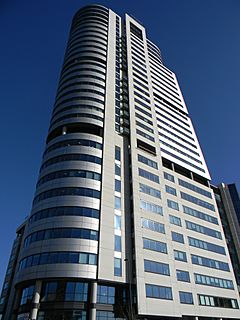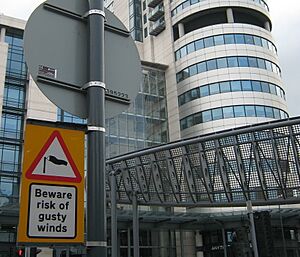Bridgewater Place facts for kids
Quick facts for kids Bridgewater Place |
|
|---|---|
 |
|
| General information | |
| Status | Complete |
| Type | Skyscraper |
| Location | Leeds, England |
| Coordinates | 53°47′31″N 1°32′52″W / 53.7920°N 1.5479°W |
| Estimated completion | 2006 |
| Opening | 2007 |
| Height | |
| Roof | 112 m (368 ft) |
| Technical details | |
| Floor count | 32 |
| Floor area | 40,000 m2 (430,000 sq ft) |
| Design and construction | |
| Architect | Aedas |
| Developer | KW Linfoot |
| Main contractor | Bovis Lend Lease |
Bridgewater Place is a very tall building in Leeds, West Yorkshire, England. It has offices and homes inside. People sometimes call it The Dalek because of its shape. When it was finished in 2005, it was the tallest building in Yorkshire. Now, another building in Leeds called Altus House is taller. You can see Bridgewater Place from as far as 25 miles (40 kilometres) away!
Building a Skyscraper: Bridgewater Place's Story
Leeds City Council first shared plans for Bridgewater Place in 2001. They wanted to build a 30-story tower costing about £80 million. The plans included eight floors for offices and shops. The rest of the building would be apartments and fancy penthouses.
Some local groups were worried about how the tall building might affect wind and shade. But the Leeds City Council was excited to have a real skyscraper in the city center. They thought construction would finish by autumn 2003.
The building was actually finished in April 2007. At that time, it was indeed the tallest and largest building in Yorkshire. It has 32 floors and stands 110 meters (368 feet) tall. It offers 40,000 square meters (400,000 sq ft) of space. Even though it was very tall, the 330-meter (1,083 feet) Emley Moor TV mast nearby was still taller.
Soon after it opened, the Yorkshire Evening Post newspaper gave it the nickname "the Dalek." This name stuck!
Understanding Wind Around Tall Buildings
After Bridgewater Place was completed in 2007, people noticed a problem. The building was making the wind much stronger around it, especially on Water Lane. It was found that the building made winds coming from the west speed up. It also created strong downward drafts of wind from the residential tower.
Wind speeds were measured as high as 79 miles per hour (127 km/h). This is as strong as a hurricane! These strong winds caused serious problems. People were injured, and once, a baby's stroller was pushed into the road by a sudden gust. Sadly, in March 2011, a man named Dr. Edward Slaney died when a lorry was overturned by a strong gust of wind.
To fix this, a special "Wind Scheme" was put in place. This project included building a canopy, five screens on the west side of the building, and three "baffles" (special structures to break up the wind) on Water Lane. These changes were finished in summer 2018. The owners of Bridgewater Place agreed to pay £903,000 for these improvements.
In December 2013, after Dr. Slaney's death, the coroner suggested that Leeds City Council should have safety rules for high winds around Bridgewater Place. The Council started these rules in February 2014. When winds were stronger than 35 mph (56 km/h), large vehicles were sent on different routes. If winds went above 45 mph (72 km/h), roads were closed to most vehicles, and people were directed to walk behind a protective screen.
In October 2019, experts checked the wind changes. They found that the new structures had made the area much safer for people. An independent expert also agreed with their findings. Because of this, Leeds City Council removed the special wind safety rules. The owners of Bridgewater Place also paid £1.223 million to cover the costs of the road closures.
The wind problems at Bridgewater Place have taught important lessons for new tall buildings. For example, in 2016, when plans for Bridge Street were made, developers said they were doing many wind tests. They wanted to make sure they would not have "another Bridgewater Place" situation.
Gallery










